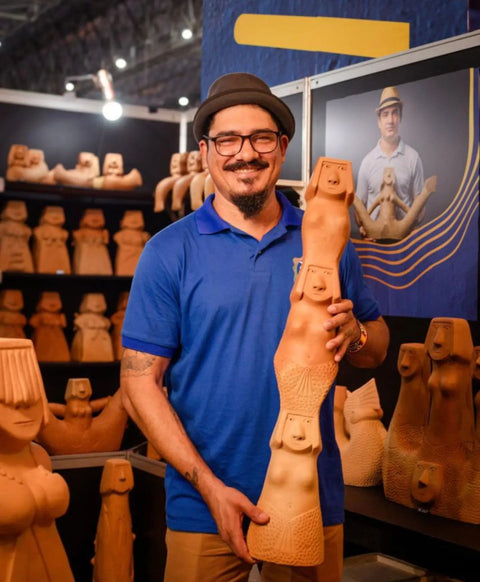


Mano de Bae, the artisan son of Master Bae, took his father's heritage and remodeled it. In his work, he expresses the Afro-Amerindian heritage of his region with a touch of poetry.
Mano de Bae remembers the time when he would sit on the floor with his brothers and watch his father hollow out the pieces. This was how he had his first contact with clay, carefully observing the finishing touches and the pieces being fired in the wood-fired kilns. His hands, already accustomed to the raw material, began to create animals and dolls based on everyday experiences and references that often came from his backyard.
Born in the Forest Belt region of Pernambuco (Northeast of Brazil), his region has clay soil and has maintained the tradition of working with clay for centuries.
Initially, indigenous communities produced plates, cups, pots and pipes. With colonization and the occupation of the land by sugarcane plantations, the potteries also began to produce roof tiles for sugar mills and their owners.
To this day, the pottery tradition is maintained in the city and is one of the main economic activities, along with sugarcane cultivation.
In the local landscape, with a humid climate, mountains and sugarcane fields predominate.
Mano de Bae developed a gas-fired kitchen kiln with his brother during his research. He is the first artisan in the region to stop using wood-fired kilns. According to him, the firing time is shorter, the pieces break less and they can have more control, including over the color.
The raw material, which used to be extracted from the city itself, now comes from other cities. The clay, which used to be black, is now white, but the technique remains the same.
“The technique I use is the same as my father's. I take the clay, make the bowl, square or cylindrical, shape it, giving it a face, a chest, etc. I cut it in half to make the hollow. Then I mend it, finish it, sign it, wait for it to dry and take it to the oven”.The tools used arise from the perceived need to create textures, finishes and are recycled from discarded objects.
Source: artesol.org.br
From the Forest Belt region of Pernambuco (Northeast of Brazil), this region has clay soil and has maintained the tradition of working with clay for centuries.
Process: Hand carved
Care: Wipe with dry Cloth
Material: Clay
Help and Support
Showroom visits
Our showroom is open to private or trade clients interested in seeing our products sold online.
Partners
We are proud to partner with Artesol, a remarkable organization that has been a beacon of hope for communities across Brazil.
Join our world
Get 10% off your first order. Sign up to be the first to know about new arrivals, sales, and special events.
